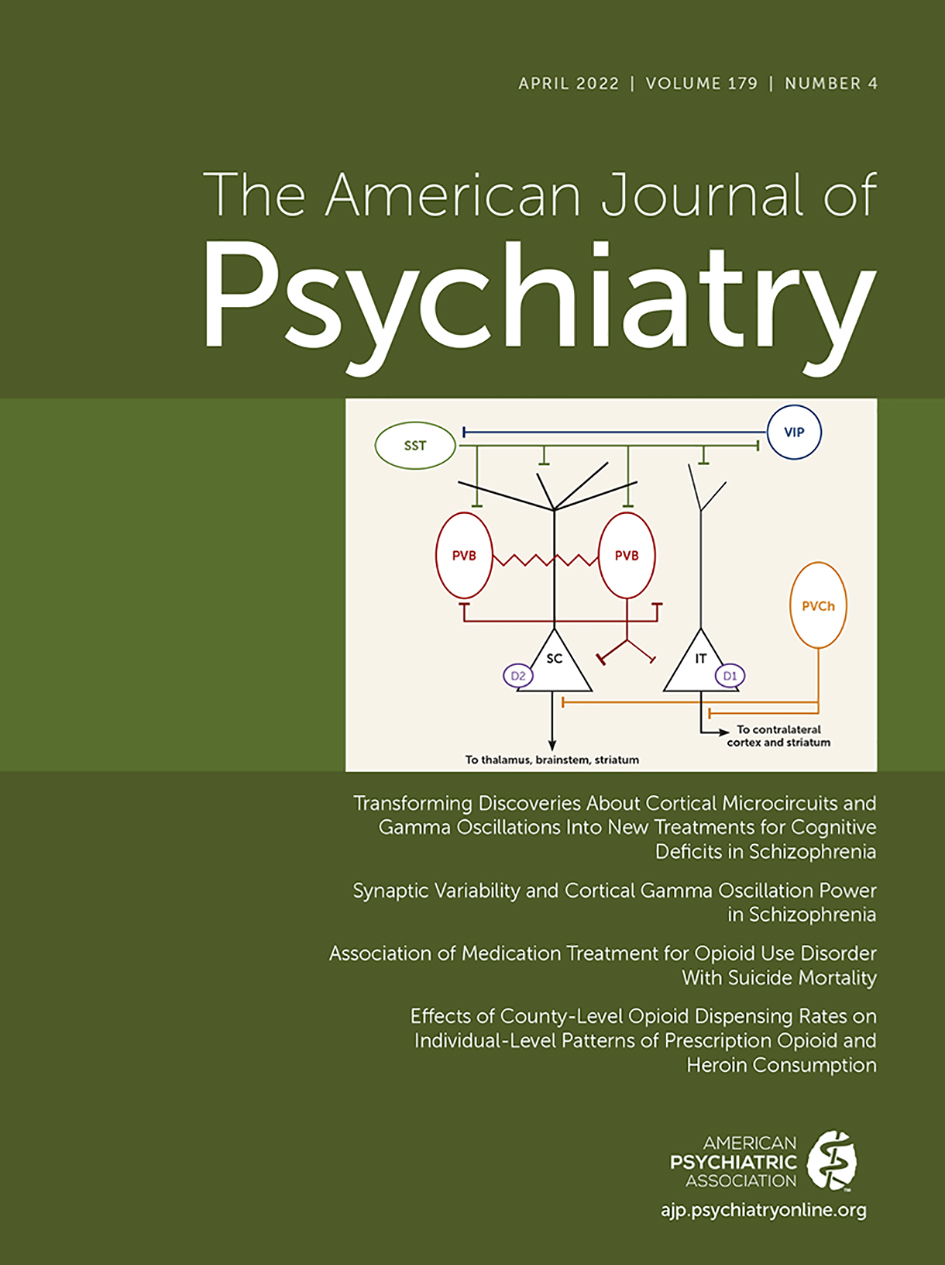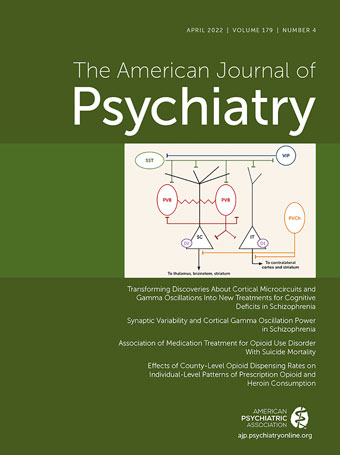The impact of delay in treatment of psychosis (i.e., the duration of untreated psychosis or DUP) on outcome (
1) is one of the two principal foundations underlying the development of early intervention services (EIS), the other being a comprehensive package of evidence-based interventions modified to fit the phase-specific needs of patients in the early phase of the illness and delivered through EIS case management (
2,
3) or coordinated care (
4,
5). While the well-established evidence of the superior effectiveness of EIS over regular care (
6) has been extended to 5 years (
7,
8) (and there are a few follow-up reports of 10 years [
9,
10]), this evidence is based almost exclusively on evaluation of the care package and not on earlier timing of intervention through reduction of DUP. The widespread implementation of EIS in many high-income countries has also mostly involved improvement in the form and content of care through varying levels of fidelity to what is regarded as an EIS care package (
2–
5).
On the other hand, relatively little attention has been paid to improving the timing of the intervention through reduction of DUP, despite the evidence for the impact of DUP on clinical and functional outcome (
1). The latter evidence comes mostly from association studies with additional support from a few experimental studies (
11–
13). The strongest support is derived from the Treatment and Intervention in Psychosis (TIPS) study in Norway. This study used a parallel-control design where one community cohort received experimental reduction of DUP through early case detection while the control community cohort received services as usual (
11,
14). The cohort that had received interventions and achieved significant DUP reduction has shown improved clinical and functional outcomes 5 and 10 years later relative to the control cohort. Other controlled studies of DUP reduction have produced results that are more equivocal (
12,
15). The new study by O’Keeffe et al. in this issue of the
Journal (
16) provides important and sound support for the long-term impact of DUP on clinical, functional, and quality of life outcomes. In this editorial, I will discuss their findings in the larger context of challenges that may limit further progress in early intervention services for psychosis.
The results of the O’Keeffe et al. study are important for several reasons in addition to the 20-year follow-up period. The results are based on a well-characterized treated incidence sample (estimated to be 26 per 100,000 per year) from a defined catchment area population. The data are derived from structured assessments, including that of DUP, conducted to assess outcome at regular intervals. This has allowed an examination of trajectories of the association between DUP and each domain of outcome while being able to control for several variables known to either influence outcome independently or through putative overlap with DUP (e.g., premorbid adjustment). The representative nature of the sample and sustained association between DUP and outcome on multiple dimensions of outcome make these findings more consistent with clinical observations and should address the issues raised (
17–
19) in response to the proposition that a lead-time bias makes the DUP/outcome relationship questionable (
20). The differences in the trajectories of DUP/outcome association, reported across different dimensions of outcome, are also congruent with differences in the nature of the outcome dimensions (positive and negative symptoms versus functioning and quality of life).
Although EIS have been implemented in many jurisdictions, there has been relatively limited attention paid to active reduction of DUP for incoming patients (
21,
22). Even pivotal controlled studies of effectiveness of EIS have reported relatively long DUP for patients treated in these services (
5,
23). There is a strong suggestion that EIS may benefit patients with a shorter DUP more than those with a long DUP, even in samples where the median DUP is relatively high (
5,
23). The actual threshold for DUP, at and above which the benefits of EIS may be relatively limited, is likely to be as low as 12 weeks, as recommended by the World Health Organization (WHO) and the International Early Psychosis Association (IEPA). This has been recently supported by empirical data from a randomized controlled study of extended EIS (5 years) versus 2 years of EIS followed by 3 years of regular care. The results suggest that the benefit of extended EIS for clinical outcome (length of symptom remission) is greater for patients with a DUP of 12 weeks or less (
24). An economic evaluation of the same data also revealed that extended EIS was cost-effective only for patients with a DUP of 12 weeks or less (
25).
Despite strong evidence for the impact of DUP on outcome, why have services not focused on actively reducing DUP? One of the reasons may be that experimental interventions to reduce DUP have not produced unequivocal success (
26). This may be because any single intervention is unlikely to be effective in different environments and that reducing DUP in any community requires a population and system-based approach (
22). Designing effective interventions to reduce DUP requires a better understanding of the structure and measurement of DUP as well as of demographic, ethnic, and cultural composition of the population served and prevalent systemic pathways to care (
22). DUP consists of at least two and more likely three components, namely delays in help-seeking and delays due to systemic and administrative issues (
21,
27). Knowledge about the determinants of each component will provide information on whether and to what extent the respective component of DUP can be influenced and, if so, by what type of intervention. For example, untreated psychosis resulting from delays in help seeking is influenced mostly by patient and illness characteristics (e.g., negative symptoms) (
27) and possibly a host of ill-defined family and cultural factors (
28). Interventions to influence these factors will require an intense effort to increase precise knowledge among the general population about psychosis, its varying presentations, and benefits of EIS in order to influence complex help-seeking behavior of entire communities. This is likely to be expensive, and the effectiveness may be limited.
On the other hand, systemic influence on DUP is substantial (
29,
30) as exemplified by the observation that when EIS are superimposed on an existing mental health system (e.g., implementation of EIS in the U.K. national health service), DUP remains high (
21). This is because the new help-seeking patients still had to negotiate existing complex pathways to care through layers of the system (primary care, generic community mental health) before they could enter EIS. Further, the systemic component of DUP is likely to be influenced by the type of service or personnel with whom the patient or family make their first help-seeking contact (e.g., physician versus nonphysician within the healthcare system; counselor or teacher in the education system; traditional healers and religious personnel) (
27,
28) and the capacity of the first contact to have knowledge about psychosis and ready access to the treatment system (e.g., EIS if they exist).
It is likely that system-related interventions to simplify pathways to care may be relatively more influential and easier to implement than influencing help-seeking behavior. A direct connection between EIS and all potential sources of referral by improving knowledge on early case identification of psychosis and combining with open and rapid access (e.g., within 72 hours) (
31) to EIS from any source are likely to facilitate quick entry. Unfortunately, a majority of patients still access EIS through hospital emergency departments (
32), a route that while likely to facilitate quick entry to EIS is fraught with other negative consequences such as trauma related to police involvement, coercion, or failure to engage in treatment. On the other hand, the first contact with a family physician, a “softer” pathway, is often a missed opportunity (
33). In addition, each system of care is likely to have additional unique barriers and may need interventions specifically designed to eliminate such barriers.
The strong evidence for sustained long-term effect of DUP on clinical, functional, and quality of life outcomes (
16) will need to be supplemented by future studies that explore how DUP interacts with other factors that influence outcome, especially the nature and quality of treatment. The latter is likely to be higher in EIS and coordinated care models. Some unexplored issues in the O’Keeffe et al. study will need greater attention in future studies. The report of a relatively high mortality rate of 12% at 20 years remains unexplored in relation to the potential role of DUP. There is evidence from a study by Anderson et al. (
34) that suggests that receiving treatment in EIS is associated with lower mortality, although these findings are based on short-term outcomes of 2 years. It remains unclear if a reduced DUP could have accounted, at least partially, for the lower rate of mortality reported in that study (
34). Further, one-third of patients in the O’Keeffe et al. study were not taking antipsychotic medication at 12 and 20 years, and it is likely this occurred much earlier (data not available). There is a suggestion that patients who manage to stop medication have better functional outcomes (
35–
37). Short DUP likely promotes better clinical and functional outcomes through a variety of mechanisms that may include one mediated through ability to stop medication after a successful period of treatment as suggested by some recent findings (
37). This needs further exploration. Such additional knowledge would not only promote reduction of DUP but also assist in treatment strategies such as continuing or stopping medication based on patient’s DUP as well as other good prognostic indicators, such as early response to treatment.
In conclusion, the results of the O’Keeffe et al. study (
16) should stimulate further research as well as systemic attention to reducing DUP, the relatively neglected foundation of early intervention in psychosis. Combining attempts at reducing DUP with a higher quality of treatment through EIS is likely to achieve large improvements in long-term outcomes for a substantial proportion of young people with a first onset of a psychotic disorder. These efforts will need to take a population-based approach, and studies will need to be conducted in a variety of real-world settings to improve their ecological validity. Contrary to concerns expressed 20 years ago (i.e., that early intervention in the psychosis paradigm may simply facilitate bringing forward the timing of treatment and not include the value of improved phase-specific treatment), ironically we now need to substantially add “intervening early” to early intervention services (
38).

